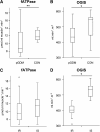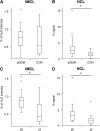Body and liver fat mass rather than muscle mitochondrial function determine glucose metabolism in women with a history of gestational diabetes mellitus
- PMID: 20978097
- PMCID: PMC3024362
- DOI: 10.2337/dc10-1002
Body and liver fat mass rather than muscle mitochondrial function determine glucose metabolism in women with a history of gestational diabetes mellitus
Abstract
Objective: Ectopic lipid storage in muscle (intramyocellular lipids [IMCL]) and liver (hepatocellular lipids [HCL]) coexists with impaired myocellular flux through ATP synthase (fATPase) in certain cohorts with increased risk of type 2 diabetes. Because women with a history of gestational diabetes mellitus (pGDM) have elevated ectopic lipids and diabetes risk, we tested whether deteriorated energy metabolism contributes to these abnormalities.
Research design and methods: A total of 23 glucose-tolerant nonobese pGDM and eight women with normal glucose metabolism during pregnancy with similar age, body mass, and physical activity underwent oral glucose tolerance tests (OGTT) and intravenous glucose tolerance tests at 4-5 years after delivery. OGTT values <463 mL ⋅ min(-1) ⋅ m(-2) were considered to indicate insulin resistance. pGDM were further stratified into insulin-resistant (pGDM-IR) and insulin-sensitive (pGDM-IS) groups. IMCL, HCL, and fATPase were measured with (1)H/(31)P magnetic resonance spectroscopy.
Results: pGDM had 36% higher fat mass and 12% lower insulin sensitivity. Log-transformed fATPase was lower in pGDM (10.6 ± 3.8 µmol ⋅ mL muscle(-1) ⋅ min(-1) vs. 12.1 ± 1.4 µmol ⋅ mL muscle(-1) ⋅ min(-1), P < 0.03) and related to plasma adiponectin after adjustment for body fat (r = 0.44, P < 0.04). IMCL were 61% and 69% higher in pGDM-IR (P < 0.05 vs. pGDM-IS) and insulin resistant women (P < 0.003 vs. insulin sensitive), respectively. HCL were doubled (P < 0.05) in pGDM and insulin resistant women, and correlated positively with body fat mass (r = 0.50, P < 0.01) and inversely with insulin sensitivity (r = -0.46, P < 0.05).
Conclusions: Glucose-tolerant pGDM show increased liver fat but only slightly lower muscular insulin sensitivity and ATP synthesis. This suggests that alteration of hepatic lipid storage represents an early and predominant abnormality in this cohort.
Figures


Similar articles
-
Increased intramyocellular lipid concentration identifies impaired glucose metabolism in women with previous gestational diabetes.Diabetes. 2003 Feb;52(2):244-51. doi: 10.2337/diabetes.52.2.244. Diabetes. 2003. PMID: 12540593
-
Plasma adiponectin, insulin sensitivity, and subclinical inflammation in women with prior gestational diabetes mellitus.Diabetes Care. 2004 Jul;27(7):1721-7. doi: 10.2337/diacare.27.7.1721. Diabetes Care. 2004. PMID: 15220253
-
Early changes in hepatic energy metabolism and lipid content in recent-onset type 1 and 2 diabetes mellitus.J Hepatol. 2021 May;74(5):1028-1037. doi: 10.1016/j.jhep.2020.11.030. Epub 2020 Nov 28. J Hepatol. 2021. PMID: 33259845
-
Gestational diabetes mellitus and subsequent development of overt diabetes mellitus.Dan Med Bull. 1998 Nov;45(5):495-509. Dan Med Bull. 1998. PMID: 9850811 Review.
-
Ectopic fat, insulin resistance and metabolic disease in non-obese Asians: investigating metabolic gradation.Endocr J. 2019 Jan 28;66(1):1-9. doi: 10.1507/endocrj.EJ18-0435. Epub 2018 Dec 4. Endocr J. 2019. PMID: 30518722 Review.
Cited by
-
Hepatic fat and glucose tolerance in women with recent gestational diabetes.BMJ Open Diabetes Res Care. 2018 Sep 8;6(1):e000549. doi: 10.1136/bmjdrc-2018-000549. eCollection 2018. BMJ Open Diabetes Res Care. 2018. PMID: 30233804 Free PMC article.
-
Hidden metabolic disturbances in women with normal glucose tolerance five years after gestational diabetes.Int J Endocrinol. 2015;2015:342938. doi: 10.1155/2015/342938. Epub 2015 Mar 22. Int J Endocrinol. 2015. PMID: 25873951 Free PMC article.
-
Insulin-Sensitizing Effects of Omega-3 Fatty Acids: Lost in Translation?Nutrients. 2016 Jun 1;8(6):329. doi: 10.3390/nu8060329. Nutrients. 2016. PMID: 27258299 Free PMC article. Review.
-
Skeletal muscle phosphodiester content relates to body mass and glycemic control.PLoS One. 2011;6(7):e21846. doi: 10.1371/journal.pone.0021846. Epub 2011 Jul 14. PLoS One. 2011. PMID: 21779337 Free PMC article.
-
Effects of raising muscle glycogen synthesis rate on skeletal muscle ATP turnover rate in type 2 diabetes.Am J Physiol Endocrinol Metab. 2011 Dec;301(6):E1155-62. doi: 10.1152/ajpendo.00278.2011. Epub 2011 Sep 13. Am J Physiol Endocrinol Metab. 2011. PMID: 21917633 Free PMC article. Clinical Trial.
References
-
- Szendroedi J, Roden M. Ectopic lipids and organ function. Curr Opin Lipidol 2009;20:50–56 - PubMed
-
- Trujillo ME, Scherer PE. Adipose tissue-derived factors: impact on health and disease. Endocr Rev 2006;27:762–778 - PubMed
-
- Thamer C, Machann J, Bachmann O, et al. Intramyocellular lipids: anthropometric determinants and relationships with maximal aerobic capacity and insulin sensitivity. J Clin Endocrinol Metab 2003;88:1785–1791 - PubMed
Publication types
MeSH terms
Substances
LinkOut - more resources
Full Text Sources
Medical
Miscellaneous

